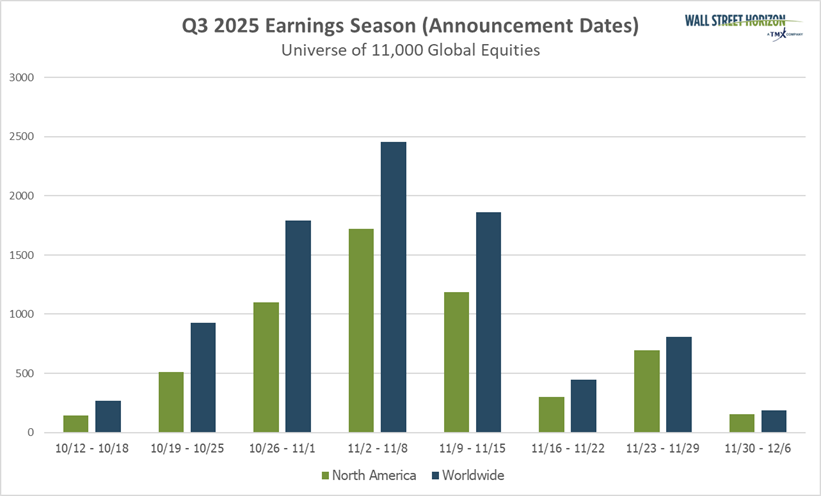Two National Guard members shot near White House
-
Value-focused retailers like Walmart and TJX are thriving as consumers cut back on discretionary items and trade down from mid-tier stores.
-
Despite near-record low consumer sentiment driven by inflation, holiday spending is expected to remain high.
-
We hear from DKS, ANF, BURL, KSS and URBN and a few final retailers this week as the Q3 earnings season comes to a close.
-
The Q4 2025 earnings season will kick off on January 13 when JPMorgan Chase reports.
What Retailers are Saying about the Health of US Consumers
A handful of retailers reported last week just as we head into Black Friday shopping season (many of the sales have already commenced), with several more results expected this week.
The winners and losers closely followed those of the Q2 earnings season; retailers that are perceived to be offering value are coming out ahead.
Off-price retailers continue to get their flowers, as TJX Companies (parent to TJMaxx, Home Goods and Marshalls) and Ross Stores both put up impressive Q3 results and raised guidance for FY 2025. These names continue to attract customers seeking value and deals across different income demographics, capitalizing on the shift away from full-price retailers.
The world’s biggest retailer, Walmart, also benefitted from this trend. When WMT reported last Thursday they beat on the top and bottom-line and raised full-year sales guidance, with comparable sales (in-store and online) growing 4.5%. The discounter attracted customers across all income levels, but noted a "slight slowdown" or "moderation in spending" in the low-income cohort. Higher-income shoppers continue to trade down to Walmart for groceries and essentials.
On the flipside, peer discounter, Target, struggled once again this earnings season. Target’s comp sales fell 2.7%, and the company lowered its full-year earnings forecast. Long-time middle- and upper-income shoppers are pulling back on non-essential purchases like apparel and home decor, which historically drove Target’s growth. They are decamping to more affordable stores like Walmart and TJX.
The home improvement retailers have also struggled. Home Depot missed Wall Street’s expectations for Q3 and lowered its full-year outlook. Even wealthier homeowners are more hesitant to spend on expensive renovations and big-ticket home improvement purchases due to higher interest rates and an uncertain outlook. Notably, home improvement peer Lowe’s did considerably better in Q3, both in terms of profit growth and comp store sales, but the company lowered its full-year profit outlook as it cited economic uncertainty.6
With 95% of S&P 500 companies reporting at this point, the Q3 2025 EPS growth rate stands at 13.4%. According to FactSet, this would be the ninth consecutive quarter of growth, and the fourth consecutive quarter of double-digit growth. Revenues are now anticipated to grow 8.4% YoY.7
This week we hear from a handful more retailers before the Black Friday shopping season officially kicks off. We’ll be looking at results from Dick’s Sporting Goods, Abercrombie & Fitch, Kohl’s, Urban Outfitters and Burlington Stores.
What the Data is Saying about the Health of the US Consumer
While the longest government shutdown in history officially ended on November 12, we’re still playing catch up with a lot of the economic data reports, therefore making the consumer picture a bit murky.
Last week we finally got the September jobs report. It showed Nonfarm Payrolls came in at 119k, better than expected but with downward revisions to prior months. Unemployment ticked up to 4.4% and average hourly earnings increased 3.8% over the past 12 months, which, while positive, is being outpaced by the consumer’s perception of high prices.
The recent Q3 Household Debt and Credit Report from the Federal Reserve Bank of NY showed household credit growth continues, with credit card balances increasing nearly 5.8% YoY in Q3, suggesting more consumers are relying on credit to cover daily expenses.
And the latest Consumer Price Index report released by the BLS for September showed that while inflation remains elevated, the rate of increase is generally slowing. This is a positive sign for the economy but still a source of frustration for consumers.
What Consumers are Saying
And then there is what consumers themselves are saying in surveys. The biggest such survey of consumer sentiment from the University of Michigan published their final November 2025 reading on Friday, showing the indicator fell to 51 (from 53.6 in October), marking the second-lowest reading on record (just above the June 2022 low). Consumers are frustrated about the persistence of high prices and weakening incomes.
The other closely watched consumer survey comes from the National Retail Federation (NRF) and tracks the expected holiday spending per household. The NRF is maintaining a bullish outlook for the 2025 holiday shopping season and anticipates total holiday sales to surpass $1T for the first time ever in 2025. According to the NRF survey, consumers plan to spend $890.49 per person on average this year on holiday gifts, food, decorations and more. This is the second-highest amount in the survey’s 23-year history, just slightly below last year’s record of $901.99. Families with children plan to spend $33 more on average on gifts this year.
That’s a Wrap
The Q3 earnings season is winding down, with 1,273 companies from our universe expected to report this week. Thus far, 83% of companies have reported earnings (out of our universe of 11,000+ global names). The fourth quarter earnings season will kick off on Tuesday, January 13 when JPMorgan Chase reports.

